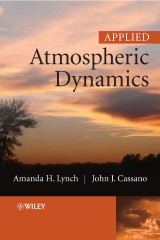Details

Applied Atmospheric Dynamics
1. Aufl.
|
62,99 € |
|
| Verlag: | Wiley |
| Format: | |
| Veröffentl.: | 11.07.2006 |
| ISBN/EAN: | 9780470861752 |
| Sprache: | englisch |
| Anzahl Seiten: | 290 |
DRM-geschütztes eBook, Sie benötigen z.B. Adobe Digital Editions und eine Adobe ID zum Lesen.
Beschreibungen
The weather can be a cause of disruption, despair and even danger everywhere around the world at one time or another. Even when benign it is a source of constant fascination. <i><b>Applied Atmospheric Dynamics</b></i> connects this interest with the theoretical underpinnings of fluid dynamics; linking real physical events as diverse as Hurricane Katrina and the strong katabatic winds of Antarctica, with quantitative conceptual models of atmospheric behaviour.<br /> <br /> Assuming only basic calculus the book provides a physical basis for understanding atmospheric motions around the globe as well as detailing the advances that have led to a greater understanding of weather and climate.<br /> <br /> The accompanying supplementary CD-ROM features colour graphics, maps, databases, animations, project materials, as well as weather data tips. <ul> <li>Covers the standard theoretical principles of atmospheric dynamics and applies the theory to global real world examples</li> <li>Assumes only non-vector based calculus</li> <li>Features supplementary CD-ROM with electronic versions of all figures, case study data and possible term projects</li> <li>An invaluable text for students of Meteorology, Atmospheric Science, Geography and Environmental Science</li> </ul> <p>A Solutions Manual is also available for this textbook on the Instructor Companion Site <a href="http://www.wileyeurope.com/college/lynch">www.wileyeurope.com/college/lynch</a></p>
PART I: ANATOMY OF A CYCLONE. <p>CHAPTER 1 ANATOMY OF A CYCLONE.</p> <p>1.1 A “TYPICAL” EXTRA-TROPICAL CYCLONE.</p> <p>1.2 DESCRIBING THE ATMOSPHERE.</p> <p>1.3 AIR MASSES AND FRONTS.</p> <p>1.4 THE STRUCTURE OF A TYPICAL EXTRA-TROPICAL CYCLONE.</p> <p>1.5 REVIEW QUESTIONS.</p> <p>CHAPTER 2 MATHEMATICAL METHODS IN FLUID DYNAMICS.</p> <p>2.1 SCALARS AND VECTORS.</p> <p>2.2 THE ALGEBRA OF VECTORS.</p> <p>2.3 SCALAR AND VECTOR FIELDS.</p> <p>2.4 COORDINATE SYSTEMS ON THE EARTH.</p> <p>2.5 GRADIENTS OF VECTORS.</p> <p>2.6 LINE AND SURFACE INTEGRALS.</p> <p>2.7 EULERIAN AND LAGRANGIAN FRAMES OF REFERENCE.</p> <p>2.8 ADVECTION.</p> <p>2.9 REVIEW QUESTIONS.</p> <p>CHAPTER 3 PROPERTIES OF FLUIDS.</p> <p>3.1 SOLIDS, LIQUIDS AND GASES.</p> <p>3.2 THERMODYNAMIC PROPERTIES OF AIR.</p> <p>3.3 COMPOSITION OF THE ATMOSPHERE.</p> <p>3.4 STATIC STABILITY.</p> <p>3.5 THE CONTINUUM HYPOTHESIS.</p> <p>3.6 PRACTICAL ASSUMPTIONS.</p> <p>3.7 CONTINUITY EQUATION.</p> <p>3.8 REVIEW QUESTIONS.</p> <p>CHAPTER 4 FUNDAMENTAL FORCES.</p> <p>4.1 NEWTON'S SECOND LAW: F=MA.</p> <p>4.2 BODY, SURFACE AND LINE FORCES.</p> <p>4.3 FORCES IN AN INERTIAL REFERENCE FRAME.</p> <p>4.4 FORCES IN A ROTATING REFERENCE FRAME.</p> <p>4.5 THE NAVIER-STOKES EQUATION.</p> <p>4.6 REVIEW QUESTIONS.</p> <p>CHAPTER 5 SCALE ANALYSIS.</p> <p>5.1 DIMENSIONAL HOMOGENEITY.</p> <p>5.2 SCALES.</p> <p>5.3 NON-DIMENSIONAL PARAMETERS.</p> <p>5.4 SCALE ANALYSIS.</p> <p>5.5 THE GEOSTROPHIC APPROXIMATION.</p> <p>5.6 REVIEW QUESTIONS.</p> <p>CHAPTER 6 SIMPLE STEADY MOTION.</p> <p>6.1 NATURAL COORDINATE SYSTEM.</p> <p>6.2 BALANCED FLOW.</p> <p>6.3 THE BOUSSINESQ APPROXIMATION.</p> <p>6.4 THE THERMAL WIND.</p> <p>6.5 DEPARTURES FROM BALANCE.</p> <p>6.6 REVIEW QUESTIONS.</p> <p>CHAPTER 7 CIRCULATION AND VORTICITY.</p> <p>7.1 CIRCULATION.</p> <p>7.2 VORTICITY.</p> <p>7.3 CONSERVATION OF POTENTIAL VORTICITY.</p> <p>7.4 AN INTRODUCTION TO THE VORTICITY EQUATION.</p> <p>7.5 REVIEW QUESTIONS.</p> <p>CHAPTER 8 SIMPLE WAVE MOTIONS.</p> <p>8.1 PROPERTIES OF WAVES.</p> <p>8.2 PERTURBATION ANALYSIS.</p> <p>8.3 PLANETARY WAVES.</p> <p>8.4 REVIEW QUESTIONS.</p> <p>CHAPTER 9 EXTRA-TROPICAL WEATHER SYSTEMS.</p> <p>9.1 FRONTS.</p> <p>9.2 FRONTAL CYCLONES.</p> <p>9.3 BAROCLINIC INSTABILITY.</p> <p>9.4 REVIEW QUESTIONS.</p> <p>PART II: ATMOSPHERIC PHENOMENA.</p> <p>CHAPTER 10 BOUNDARY LAYERS.</p> <p>10.1 TURBULENCE.</p> <p>10.2 REYNOLDS DECOMPOSITION.</p> <p>10.3 GENERATION OF TURBULENCE.</p> <p>10.4 CLOSURE ASSUMPTIONS.</p> <p>10.5 PROBLEM SET.</p> <p>CHAPTER 11 CLOUDS AND SEVERE WEATHER.</p> <p>11.1 MOIST PROCESSES IN THE ATMOSPHERE.</p> <p>11.2 AIR MASS THUNDERSTORMS.</p> <p>11.3 MULTI-CELL THUNDERSTORMS.</p> <p>11.4 SUPERCELL THUNDERSTORMS AND TORNADOES.</p> <p>11.5 MESOSCALE CONVECTIVE SYSTEMS.</p> <p>11.6 REVIEW QUESTIONS.</p> <p>CHAPTER 12 TROPICAL WEATHER.</p> <p>12.1 SCALES OF MOTION.</p> <p>12.2 ATMOSPHERIC OSCILLATIONS.</p> <p>12.3 TROPICAL CYCLONES.</p> <p>12.4 PROBLEM SET.</p> <p>CHAPTER 13 MOUNTAIN WEATHER.</p> <p>13.1 INTERNAL GRAVITY WAVES.</p> <p>13.2 FLOW OVER MOUNTAINS</p> <p>13.3 DOWNSLOPE WINDSTORMS.</p> <p>13.4 REVIEW QUESTIONS.</p> <p>CHAPTER 14 POLAR WEATHER.</p> <p>14.1 KATABATIC WINDS.</p> <p>14.2 BARRIER WINDS.</p> <p>14.3 POLAR LOWS.</p> <p>14.4 REVIEW QUESTIONS.</p> <p>CHAPTER 15 EPILOGUE: THE GENERAL CIRCULATION.</p> <p>15.1 THE GREENHOUSE EFFECT.</p> <p>15.2 RADIATIVE-CONVECTIVE EQUILIBRIUM.</p> <p>15.3 THE ZONAL MEAN CIRCULATION.</p> <p>15.4 THE ANGULAR MOMENTUM BUDGET.</p> <p>15.5 THE ENERGY CYCLE.</p> <p>APPENDIX 1: SYMBOLS.</p> <p>APPENDIX 2: CONST.</p>
"…a recommended text for an introductory level weather systems or geophysical fluid dynamics course…" (<i>Area</i>, 2007)
<p><strong>Dr Amanda Lynch</strong> and <strong>Dr John Cassano</strong>, CIRES, University of Colorado at Boulder, USA.
The weather can be a cause of disruption, despair and even danger everywhere around the world at one time or another. Even when benign it is a source of constant fascination. <b>Applied Atmospheric Dynamics</b> connects this interest with the theoretic underpinnings of fluid dynamics; linking real physical events as diverse as Hurricane Katrina and the strong katabatic winds of Antarctica, with quantitative conceptual models of atmospheric behaviour. <p>Assuming only basic calculus the book provides a physical basis for understanding atmospheric motions around the globe as well as detailing the advances that have led to a greater understanding of weather and climate.</p> <p>The accompanying supplementary cd-rom features colour graphics, maps, databases, animations, project materials, as well as weather data tips.</p> <ul> <li>covers the standard theoretical principles of atmospheric dynamics and applies the theory to global real world examples;</li> <li>assumes only non-vector based calculus;</li> <li>features supplementary cd-rom with electronic versions of all figures, case study data and possible term projects;</li> <li>an invaluable text for students of Meteorology, Atmospheric Science, Geography and Environmental Science.</li> </ul>

















